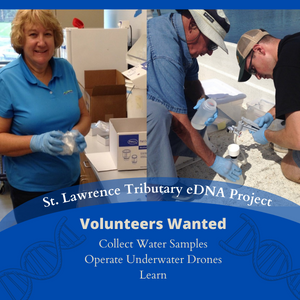This article was featured in the 2021 Autumn Newsletter by Jacob Wojcik– SLELO PRISM/TNC.
PROJECT IMPORTANCE:The practicality of eDNA stems from the fact that all biological life will shed some amount of their genetic material into their respective environments (water, soil, air, etc). So even without seeing whole organisms, eDNA provides the ability to determine if they are present or at least are in the vicinity of where the detection
was made. This project will allow us to determine the presence, or non-presence, of target native and invasive species.
From the native fishes perspective, this project will serve as an important contribution to observations made on the spawning behaviors of native Coregonines, or “whitefish”, in Lakes Superior and Michigan. Researchers in these upper Great Lakes observed these fishes utilizing tributaries to fulfill the spawning portion of their life history. These findings have called into question if our (Lake Ontario) whitefishes are performing this behavior as well.
As for the invasive species in our region, this project will allow us to get an idea about where invasions may be occurring and what steps we can take next to manage them. This project has the potential of continuing to highlight the effectiveness of eDNA analysis as an early detection tool for invasive species.
THE OPPORTUNITY:
SLELO PRISM and The Nature Conservancy are very excited to introduce and invite participation for our 2021 Tributary eDNA project. eDNA, or “Environmental DNA”, is a burgeoning scientific tool with a lot of promise for answering important ecological questions. We will be collecting water samples within 15 tributaries spanning from Oswego, NY all the way up to Massena, NY. These samples will be analyzed to observe potential detections of native and invasive species. If you are interested in assisting with these efforts, visit sleloinvasives.org/eDNA
VOLUNTEER TASKS:
There are many tasks that volunteers will be able to assist with. The primary ones are:
- Photography/Videography
- Collecting Water Samples
- Sample Transport



